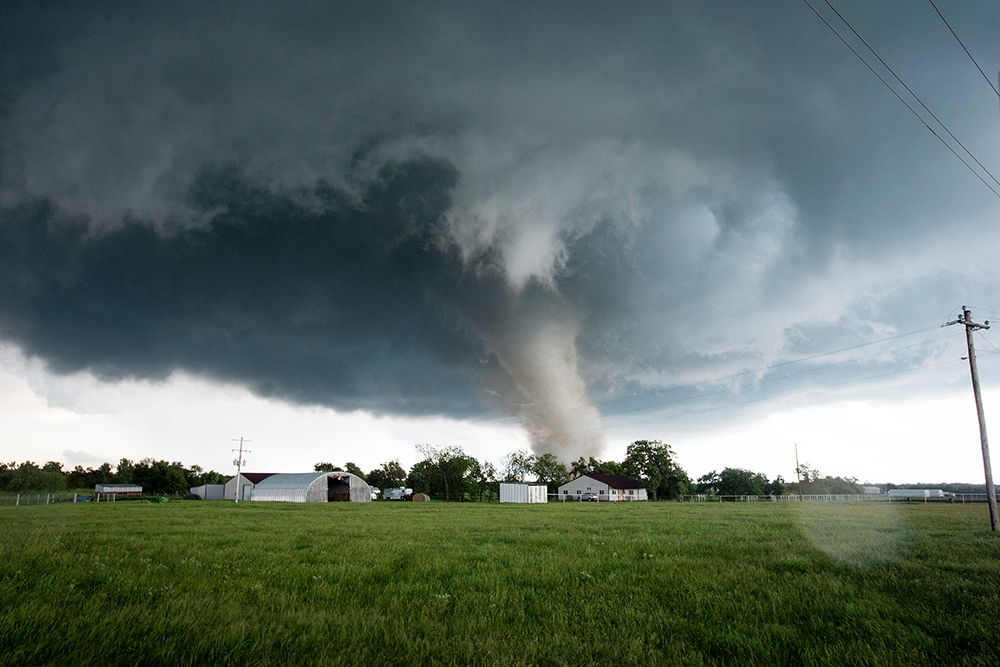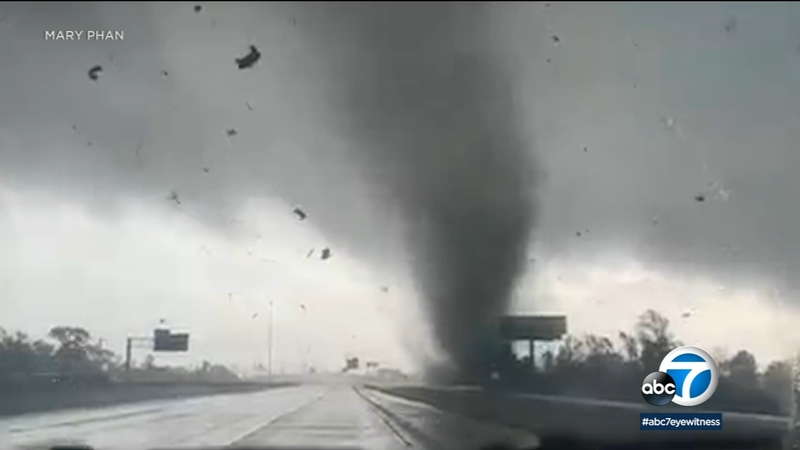About Tonedoes
In the United States, there is a cold and dry air mass
made in northern Canada, and in the southeast,
there is a hot and humid air mass that ate the heat of
the sea. Tornadoes frequently occur in the central
region in spring when these two air masses collide.
This year is also the time to be careful. Let's find out
why tornadoes occur and how to prevent tornadoes.

How do tornadoes occur?
Tornado is a type of strong wind that occurs in plains or seas, and is a high-speed vortex. It is sometimes called a twister or cyclone. Tornadoes are observed in all parts of the world except Antarctica, but mainly in the Great Plains of the United States.
There are various shapes and sizes of tornadoes, but they are usually funnel-haped. In terms of size, the average diameter is 150 to 600m and moves at 40-80km per hour. In general, the life expectancy is short, so the average career length is only 10km. Looking at the frequency of tornadoes, in the United States, the frequency of occurrence is high in spring, but the frequency of occurrence is low in winter, resulting in an average of six tornadoes a day in May, while an average of 0.5 tornadoes occur a day in December and January.
So far, atmospheric scientists have not clearly identified how tornadoes begin to form. However, according to the results of studies so far, tornadoes are formed when hot and humid air rises in a conditional unstable environment.
In other words, the hidden heat of the red cloud, which develops vertically on the ground and looks like a mountain or a large tower, heats the air in the cloud, creating a strong upward airflow. Afterwards, the rising air rotates slowly near the top of the cloud, and it gradually expands downward to form a funnel shape, which becomes a tornado when it touches the ground.
Therefore, in the vicinity of the vortex, a very strong ascending airflow violently winds up various things on the ground like a vacuum cleaner, while in the vicinity of the center, a descending airflow appears to balance the rising airflow outside.
In general, the central atmospheric pressure of a tornado is up to 10% lower than its surroundings. Tornadoes also have colors, which are affected by the color of the soil in the area where tornadoes occurred. For example, tornadoes that have moved through mountainous areas covered with snow are white, and tornadoes in the Great Plains of the United States are red due to the influence of red soil.
| F Scale | Character | Estimated winds | Description |
| Zero (F0) | Weak | 40-72 mph | Light Damage. Some damage to chimneys; branches broken off trees, shallow-rooted trees uprooted, sign boards damaged. |
| One (F1) | Weak | 73-112 mph | Moderate damage. Roof surfaces peeled off; mobile homes pushed foundations or overturned; moving autos pushed off road. |
| Two (F2) | Strong | 113-157 mph | Considerable damage. Roofs torn from frame houses; mobile homes demolished; boxcars pushed over; large trees snapped or uprooted; light objects become projectiles. |
| Three (F3) | Strong | 158-206 mph | Severe damage. Roofs and some walls torn from well- constructed houses; trains overturned; most trees in forested area uprooted; heavy cars lifted and thrown. |
| Four (F4) | Violent | 207-260 mph | Devastating damage. Well- constructed houses leveled; structures with weak foundation blown some distance; cars thrown; large missiles generated. |
| Five (F5) | Violent | 260-318 mph | Incredible damage. Strong frame houses lifted off foundations, carried considerable distances, and disintegrated; auto-sized missiles airborne for several hundred feet or more; trees debarked. |

Tornado safety tips
■ How to get notifications
- Outdoor sirens : sirens may be useful but are not always the best way to receive tornado warnings because they are not widespread, but if you are nearby, it is better to refer to them and act immediately.
- Local television : Local broadcasting stations provide broadcasting in the area in case of bad weather, but it is difficult to receive information if a tornado alarm occurs at night, but you will be able to grasp the situation.
- NOAA Weather Radio : It may sound outdated, but the weather radio provides updates directly from the nearest National Weather Service forecast office.
- Mobile phone : wireless emergency alerts are one of the best ways to receive tornado alerts anytime, anywhere. That's why it's always good to keep the emergency alert sign on. Then, you can be guided the fastest and cope with it.
■ Let's know the safest shelter
- The basement : basement is the safest place to protect yourself from the strong winds of tornadoes.
- The first floor of the interior room : In the house, this place can be a bathroom or closet without windows. That's why it's good to have as many strong places as possible in the house.
■ Place to be careful
- Mobile housing (trailer) : Trailer is one of the most dangerous places during tornadoes because it is light and easily falls in strong winds. If you receive a tornado warning while in a mobile house, you'd better move to the nearest sturdy building. If a reliable shelter is not available, the next best option is to lie in a ditch and protect your head from debris flying away.
- Cars : vehicles cannot be said to be a safe place for tornadoes. However, people wearing belts in cars are generally safer than those staying in mobile homes. Therefore, if you board a vehicle during a tornado warning, it is best to evacuate to the nearest safe building from the vehicle. If that's not possible, experts suggest wearing seat belts and crouching down in the car or abandoning the car and lying down in a nearby ditch.
Even in this case, you should check whether the information is updated and always works, such as a cell phone or radio. If you plan to visit a shelter in a public building, make sure it is available 24 hours a day 24/7.
■ Avoid dangerous places
- Under the highway : if trapped in a car, evacuating under the bridge may seem like a good choice, but a narrow passage can act like a funnel to amplify the wind.
- Outdoor : there is no safe option if trapped outside during tornado warnings with no permanent shelter nearby. Therefore, as an absolute last resort, you have to curl up and cover your head far away from trees or other independent objects and at the lowest place you can find them.
- High-rise building : If you live on a high-rise apartment or work in a high-rise office building, you should find a way to evacuate safely on the first floor. Internal corridors can be the safest.
- Warehouses, department stores, grocery stores : structures with large open spaces are particularly vulnerable to collapse even in relatively weak tornadoes. So, if possible, it is better to find a small, enclosed space to evacuate and avoid the exterior wall of the building.
■ Protect yourself
- Cover your hair : the best advice is to keep your helmet close. Cover your head with your arms at least. If you have time, covering the mattress can also help maintain safety.
- Speak up : Meteorologists suggest maintaining horns or whistles every time they evacuate so that emergency rescue workers can hear them if they are buried in debris.
- Prepare the items : store the necessary first aid materials in the shelter in case of injury.
- Wear shoes : If a tornado occurs, there may be dangerous fragments that you do not want to step on.
- Avoid dangerous materials : If trapped in a damaged building, keep your distance from fallen wires, broken gas wires, and sharp objects.

'Global story' 카테고리의 다른 글
| Seoul Trail Courses (Dule-gil Course), Good for Walking (0) | 2022.04.10 |
|---|---|
| TOPIK Test Schedule and How to Register for the TOPIK (0) | 2022.03.22 |
| Cherry Blossom Peak Bloom and festival in Washington, DC (0) | 2022.03.12 |
| 미국의 떠오르는 지역 선 벨트 (0) | 2022.01.09 |
| [월스트리트 뉴스 요약] WeWork 공동 창업자 아담 노이만, 레지던스 거물이 되다. (0) | 2022.01.05 |









최근댓글